Ball compression valve - features and purpose
For installation of plastic and metal-plastic pipes without the use of welding joints, compression (collet) fittings are used. In particular, the collet ball valves, which, in fact, is the subject of this article, are used as stop valves. Below we look at what they are and what is their feature.
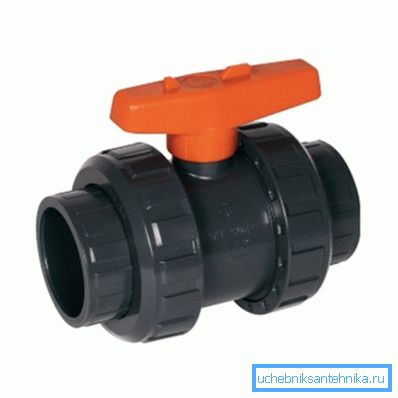
Features of collet ball valves
The design of the compression ball valve is not different from the usual ball valves. Those. The device is designed to completely block the water in pipelines of small diameter. Most often, such valves are used in water supply systems (hot and cold), as well as heating.
A ball valve is called because its locking mechanism is designed as a ball with a through hole. To shut off the water supply, the ball valve element should be rotated 90 degrees so that the through hole is perpendicular to the pipe.
Note! Any ball valves are not designed to regulate the flow of fluid in the pipe. It can only be used to completely open or shut off the supply of water or other liquid.
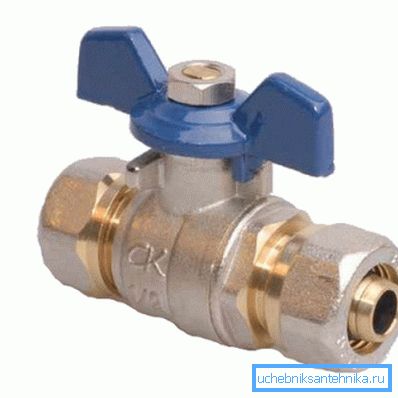
The difference between compression cranes and other similar valves is only in the method of installation, which is carried out using a collet. Another such connection method is called clamping, since this mounting system provides a pipe clamp when the nut is tightened.
The great popularity of the considered fittings is due to the fact that their installation does not require special tools and skills, thanks to which installation can be done by hand.
Most often, this method of installation is used for polyethylene pipes and pipelines of metal-plastic. Below are the main characteristics of the HDPE collet check valves:
| Diameter | 16 mm to 110 mm |
| Maximum pressure | Up to 16 atmospheres - with a diameter of 63 mmDo 10 atmospheres - with a diameter of over 63 mm |
| Durability | 25 years or more, depending on operating conditions |
| Maximum working temperature | 45 degrees |
I must say that the products in question can be made not only from HDPE, but also from other materials, such as:
- Brass;
- Bronze;
- Copper;
- Of stainless steel.
In this case, the locking mechanism itself is often made of stainless steel, as a result of which it is resistant to corrosion.
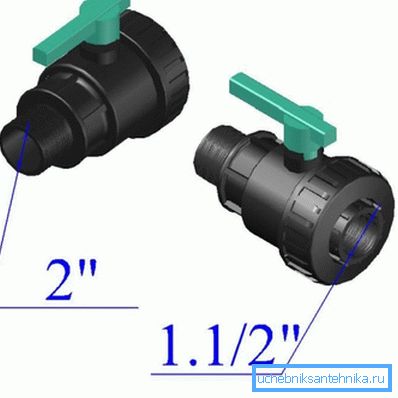
Merits
Among the advantages of compression ball valves can be identified the following points:
- Simplicity and high speed of installation thanks to what labor costs are reduced;
- Reliability.
- Durability.
- Low price.
- The possibility of dismantling.
Note! For high-quality installation of a collet fitting for pipes, the diameter of its pipes must exactly match the diameter of the pipes.
disadvantages
Of course, as is often the case, along with the advantages, these products have some drawbacks, the main of which are listed below:
- The fittings considered are designed for less pressure than similar products for soldering, as the compression connection is still less durable.
- During operation, there may be a need to tighten the connection.
- Despite the fact that the design is considered reusable, i.e. it can be assembled and disassembled; in practice, re-assembly is unreliable, with the result that the fitting has to be changed.
- As mentioned above, the ball valve can not regulate the water pressure, as this may lead to its early failure.
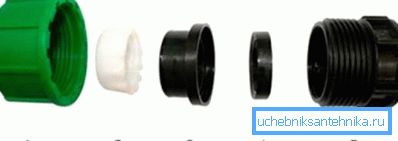
The device of the compression connection and installation of the crane
As an example, consider a PND compression crane 32 mm by 32 mm.
The mounting system includes the following parts:
- Clamping nut;
- Clamping ring;
- Compression ring;
- Sealing ring;
- The main body.
As a rule, a similar mount is available on the opposite pipe. True, there are devices that serve as adapters. In this case, on the one hand, they have a collet, and on the other hand, a nozzle for a threaded or other connection.
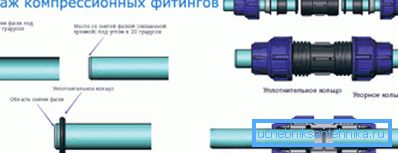
Installation instructions for collet valves are as follows:
- First of all, you need to cut the pipe smoothly so that the cut is perpendicular to its axis. Thanks to this pruning, the pipe will completely rest against the locking protrusion of the housing.
- Next, you need to remove burrs and other irregularities, as well as chamfer 2-3 mm from the edge, in order to get a cone.
- Then you need to insert the pipe into the device and note how deep it will sink.
- The area of the pipe that will be immersed in the housing should be lubricated with sanitary grease.
- Next, the pipe is worn parts in the following sequence:
- clamping nut;
- grip (clamping ring);
- retaining ring;
- sealing ring.

- If the compression ball valve of the collet - collet is mounted, then a similar connection with the pipeline and its second branch pipe should be made.
This completes the installation process of the collet tap.
Conclusion
Compression ball valves have a number of positive aspects, the main of which is ease of installation. Therefore, recently they have become widespread. However, it should be borne in mind that their durability depends on the quality of the installation and operating conditions, which must correspond to the characteristics of the product.
From the video in this article, you can pick up some additional information on the designated topic.